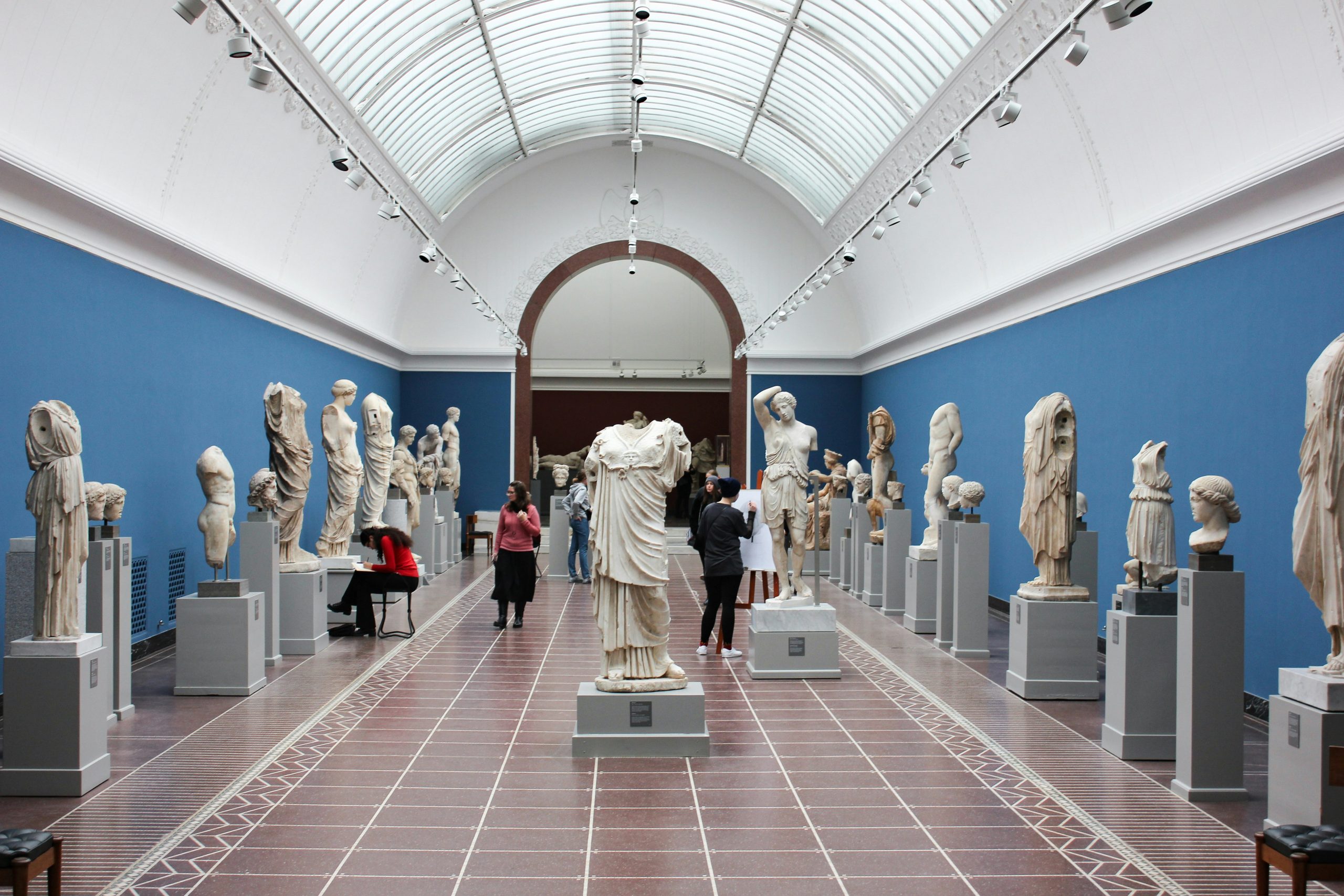
01 Apr Interactive Elements in Art Collection Exhibitions
Add Your Heading Text Here
The traditional approach has long involved passive observation, with visitors quietly moving from one piece to another, absorbing information from placards and guided tours. However, in recent years, there has been a notable shift towards incorporating interactive elements to enrich the visitor experience. This evolution stems from a recognition of the growing importance of visitor engagement and interactivity in the art world.
Benefits of Interactive Elements

Photo by aranprime
Increased Engagement and Active Participation
When visitors encounter interactive elements within the exhibit, they are encouraged to actively engage with the artworks on display. Rather than simply observing from a distance, these interactive features prompt visitors to become involved in the artistic experience. By allowing individuals to touch, manipulate, or interact with the pieces in some way, the exhibit transforms from a passive viewing activity into a dynamic and engaging exploration. Whether through tactile installations, digital interfaces, or other interactive mediums, visitors are invited to immerse themselves in the art, fostering a deeper sense of connection and participation.
Deeper Understanding and Connection to the Artworks
Through hands-on exploration and multimedia experiences, visitors have the opportunity to delve beyond surface-level observations and gain a richer understanding of the artworks presented. By engaging with multimedia content, such as videos, audio guides, or interactive displays, visitors can uncover the context, techniques, and underlying meanings embedded within the pieces. This interactive approach not only facilitates a deeper appreciation for the artwork but also fosters a stronger emotional and intellectual connection between the audience and the art. By actively exploring and interpreting the pieces within the exhibit, visitors forge meaningful connections that resonate on a personal level, enhancing their overall experience and understanding of the artwork.
Enhanced Accessibility and Inclusivity for Diverse Audiences
Incorporating interactive elements into art exhibitions serves to make the experience more accessible and inclusive for a wide range of visitors. These interactive features can accommodate diverse learning styles and accessibility needs, ensuring that individuals of all ages, backgrounds, and abilities can fully engage with the artworks on display. By offering alternative modes of interaction beyond traditional viewing, such as tactile exhibits or audio descriptions, interactive elements help to break down barriers and create a more welcoming environment for everyone to enjoy and appreciate art.
Improved Learning and Retention of Information
Active participation in interactive activities within art exhibitions enhances visitors’ learning experiences and improves their retention of information. When individuals engage directly with the artworks through interactive features, they are more likely to absorb and internalize key details about the pieces, including their historical and cultural significance, techniques used by the artist, and thematic elements explored. This hands-on approach to learning not only deepens visitors’ understanding of the art but also fosters a sense of curiosity and inquiry, encouraging them to explore further and learn more about the artistic process and context.
Creation of a More Memorable and Enjoyable Experience
The integration of interactive elements adds an element of novelty and excitement to art exhibitions, enhancing the overall visitor experience. By providing opportunities for active engagement and participation, interactive features captivate visitors’ attention and stimulate their senses, creating memorable moments that leave a lasting impression. Whether through interactive installations, digital interfaces, or immersive multimedia experiences, these interactive elements evoke curiosity, spark creativity, and inspire wonder, making the art exhibition more enjoyable and engaging for all who attend. As a result, visitors leave with not only a deeper appreciation for the art but also fond memories of their interactive journey through the exhibition.
Considerations for Implementing Interactive Elements

Photo by Laurédane Collin
Aligning with Exhibition Theme and Objectives
Interactive elements within an exhibition should be thoughtfully designed to align with the overarching theme and objectives. Whether they serve to amplify the message of the exhibition, provide deeper insights into the featured artworks, or engage visitors in meaningful dialogue, interactive elements should complement the overall narrative and enhance the visitor experience.
Respect for Artworks and Safety
While incorporating interactive elements, utmost care must be taken to ensure the safety and preservation of the artworks on display. Interactive installations should be designed and implemented in a way that minimizes the risk of damage or alteration to the art pieces. Protective measures such as barriers, signage, and monitoring can help maintain the integrity of the artwork while still allowing for interactive engagement.
Catering to Different Learning Styles and Accessibility Needs
Inclusivity is paramount when designing interactive elements for exhibitions. It’s essential to consider the diverse learning styles and accessibility needs of visitors to ensure that everyone can fully participate and engage with the exhibition content. This may involve providing alternative formats, tactile experiences, audio descriptions, or other accommodations to make the interactive elements accessible to individuals with varying abilities and preferences.
Providing Clear Instructions and User-Friendly Interfaces
Clarity and user-friendliness are key factors in maximizing visitor engagement with interactive elements. Clear instructions should be provided to guide visitors on how to interact with the exhibits effectively. Intuitive interfaces and user-friendly design features can help streamline the interaction process, making it easy for visitors to navigate and explore the interactive components without confusion or frustration.
Evaluating Effectiveness
Continuous evaluation and feedback mechanisms are essential for assessing the effectiveness of interactive elements within an exhibition. Through visitor surveys, observation, and data analysis, organizers can gather valuable insights into the impact of interactive features on visitor experience, learning outcomes, and overall satisfaction. Based on this feedback, necessary adjustments, and improvements can be made to optimize the interactive elements and ensure that they continue to align with the exhibition’s objectives and meet the needs of its audience.

Photo by Laurédane Collin
Conclusion
The integration of interactive elements into art collection exhibitions represents a significant evolution in the way audiences engage with and experience artworks. By encouraging active participation, fostering deeper understanding and connection, enhancing accessibility, improving learning outcomes, and creating memorable experiences, interactive features enrich the overall visitor experience and contribute to a more inclusive and dynamic art environment. However, the implementation of interactive elements requires careful consideration and planning to ensure alignment with exhibition themes, respect for artworks, inclusivity, clarity of instructions, and ongoing evaluation of effectiveness. By addressing these considerations thoughtfully, organizers can create immersive and engaging exhibitions that resonate with diverse audiences, spark curiosity, and inspire meaningful connections with art. As the art world continues to evolve, the thoughtful integration of interactive elements promises to play a pivotal role in shaping the future of museum experiences, fostering creativity, and expanding access to art for all. Through innovation, collaboration, and a commitment to enhancing visitor engagement, interactive exhibitions can continue to inspire and educate audiences for generations to come.
Key Takeaways
- Increased Engagement and Participation: Interactive elements encourage active engagement with artworks, transforming the viewing experience into a dynamic exploration.
- Deeper Understanding and Connection: Hands-on exploration and multimedia experiences help visitors gain a richer understanding and emotional connection to the artworks on display.
- Enhanced Accessibility and Inclusivity: Interactive features make art exhibitions more accessible to diverse audiences by accommodating different learning styles and accessibility needs.
- Improved Learning and Retention: Active participation enhances learning experiences and improves retention of information about the artworks.
- Creation of Memorable Experiences: Interactive elements add novelty and excitement, creating memorable and enjoyable experiences for visitors.
FAQs
Are interactive elements suitable for all types of art exhibitions?
The integration of interactive elements into art exhibitions can significantly enrich the viewer experience, fostering deeper engagement and understanding of the artworks on display. However, the appropriateness of such elements hinges on various factors, including the thematic content of the exhibition, its overarching objectives, and the characteristics of the target audience. For instance, while interactive components may seamlessly complement contemporary art showcases focused on technological innovation or immersive experiences, they might not align as well with exhibitions showcasing classical or historical artworks, where traditional modes of presentation might be more suitable. Therefore, curators and organizers must carefully assess the context and purpose of the exhibition to determine whether interactive elements would enhance or detract from the overall visitor experience.
How can museums ensure that interactive elements are accessible to visitors with disabilities?
Ensuring accessibility is a fundamental aspect of designing interactive elements for museum exhibitions. To accommodate visitors with disabilities, museums should adopt inclusive design principles that prioritize accessibility from the outset of the exhibition planning process. This involves creating interactive elements that are compatible with assistive technologies such as screen readers, tactile displays, or captioning systems. Additionally, museums should provide alternative formats for content delivery, such as braille descriptions, audio guides, or tactile models, to cater to diverse needs and preferences. By embracing universal design principles and consulting with accessibility experts, museums can create inclusive environments where visitors of all abilities can fully participate and engage with interactive exhibits.
What role does visitor feedback play in improving interactive exhibitions?
Visitor feedback serves as a critical tool for evaluating the effectiveness of interactive exhibitions and identifying areas for improvement. By soliciting feedback from visitors, museums gain valuable insights into the strengths and weaknesses of interactive elements, as well as the overall visitor experience. Analyzing feedback allows museums to gauge visitor satisfaction, assess the clarity and usability of interactive displays, and identify any barriers or challenges encountered by visitors. This information enables curators and designers to refine interactive elements, adjust exhibit layouts, and implement modifications that enhance accessibility, usability, and engagement. Moreover, by actively soliciting and incorporating visitor feedback into the exhibition development process, museums demonstrate a commitment to continuous improvement and responsiveness to the needs and preferences of their audience, fostering a more inclusive and enriching museum experience for all.
Jump into the guide “Funding and Support for Community Art Projects” that provides guidance on securing funding and support for community art projects, emphasizing strategies for engaging stakeholders and accessing diverse funding sources to promote community involvement and sustainability.

